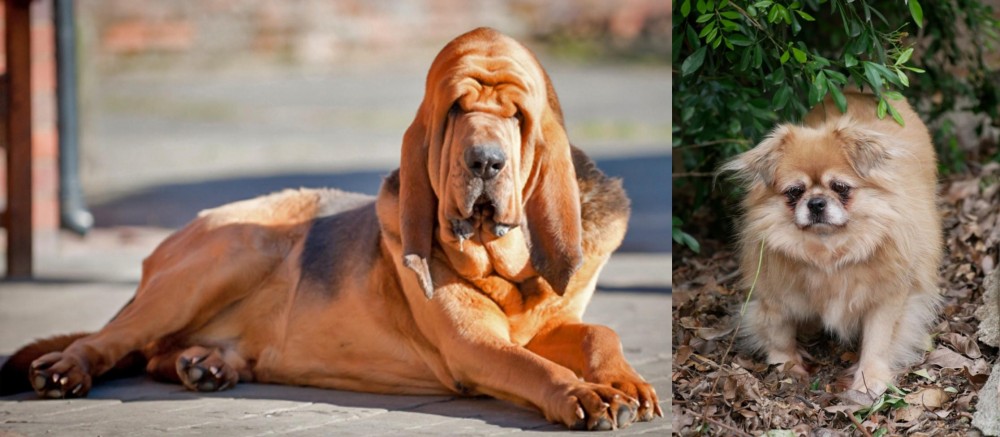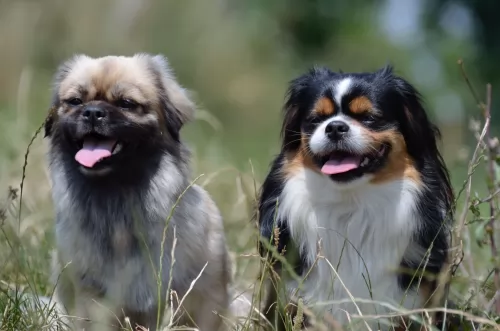 Petzlover
Petzlover Bloodhound is originated from United Kingdom but Tibetan Spaniel is originated from China. Bloodhound may grow 24 cm / 10 inches higher than Tibetan Spaniel. Bloodhound may weigh 65 kg / 144 pounds more than Tibetan Spaniel. Bloodhound may live 7 years less than Tibetan Spaniel. Bloodhound may have more litter size than Tibetan Spaniel. Bloodhound requires Low Maintenance. But Tibetan Spaniel requires Moderate Maintenance
Bloodhound is originated from United Kingdom but Tibetan Spaniel is originated from China. Bloodhound may grow 24 cm / 10 inches higher than Tibetan Spaniel. Bloodhound may weigh 65 kg / 144 pounds more than Tibetan Spaniel. Bloodhound may live 7 years less than Tibetan Spaniel. Bloodhound may have more litter size than Tibetan Spaniel. Bloodhound requires Low Maintenance. But Tibetan Spaniel requires Moderate Maintenance
 The history of the Bloodhound breed is a fascinating one. Known as a Sleuthhound for its ability to smell out the culprit and bag the prey. Even more so the Bloodhound is known for tracking and finding lost people. He is famous for finding human scents and being able to follow them even days or weeks after the person is lost. They are also able to track people over a great amount of land and have been known to successfully track escaped prisoners or wanted criminals. They are descended from the Saint-Hubert Hounds that were bred at the Abbey/Monastery at Saint-Hubert, Belgium. According to the legends the St. Hubert hounds were bred by the Monks in 1000AD. This hound was thought to be a mixed breed rather than a purebred. That’s because the ancestry of this hound is not really known but it is known that the monks bred them and sent several to the King of France annually. Only black hounds were gifted.
The history of the Bloodhound breed is a fascinating one. Known as a Sleuthhound for its ability to smell out the culprit and bag the prey. Even more so the Bloodhound is known for tracking and finding lost people. He is famous for finding human scents and being able to follow them even days or weeks after the person is lost. They are also able to track people over a great amount of land and have been known to successfully track escaped prisoners or wanted criminals. They are descended from the Saint-Hubert Hounds that were bred at the Abbey/Monastery at Saint-Hubert, Belgium. According to the legends the St. Hubert hounds were bred by the Monks in 1000AD. This hound was thought to be a mixed breed rather than a purebred. That’s because the ancestry of this hound is not really known but it is known that the monks bred them and sent several to the King of France annually. Only black hounds were gifted.
Some kings preferred not to hunt with these hounds thinking them not good enough while others thought the only use for them was as a leash hound. All described the St. Hubert as long in body with short legs. These gifts continued until the French Revolution when hunting in France was greatly reduced until the 19th century. The original St. Hubert strain became extinct in the 19th century and that the current European St. Hubert hound has its origins in the Bloodhound. The Bloodhound as a separate breed was already established in Europe by the middle of the 14th century. They were used as leach hounds to sniff out the prey so that the pack hounds could chase and keep it “at bay”. They were also used from the beginnings of the breed to track humans. At this time they were often known as sleuth hounds. As recorded by John Caius – the authority on Bloodhounds from their origins – writes about the breeds ability to find and track the scent of blood – thus becoming the Bloodhound and its use to track poachers and thieves. He also reported that the Bloodhound and the Sleuth Hound were the same basic breed. The number of Bloodhounds in Britain gradually declined until few remained after World War II. Britain has gradually built their breed back up by importing dogs from America. It was during the 19th century that the Bloodhound was imported into France by breeders who wished to reestablish the St. Hubert Hound. Thus the St. Hubert is both the ancestor and descendent of the Bloodhound. The Britain’s continue to believe that the Bloodhound is a native British breed.
The Bloodhounds in America have had great success as companion animals, with police departments and forest rangers and showing in the prestigious Westminster Kennel Club in New York. There are more Bloodhounds in the United States than anywhere else in the world.
In the end the Anglo-Saxton Bloodhound cannot be specified with any real certainty. Many believe it was not the St. Hubert that the Bloodhound descended from but rather the Norman hound or the sleuth-hound. Many believe it could have included other breeds such as the southern hound, the dun-hound and the Talbot. It cannot be proven today it the Bloodhound’s origins come from Belgian or England.
 Known fondly as the Tibbie and being referred to as little lions’, the Tibetan Spaniel is an ancient dog breed.
Known fondly as the Tibbie and being referred to as little lions’, the Tibetan Spaniel is an ancient dog breed.
They appear in ancient art dating way back to 1100BC. This tells you that this small dog has been around for a jolly long time.
When you look at him, you can see that his predecessors were the Pekingese and the Lhaso Apso. It’s odd actually that he is called spaniel, as he doesn’t look like a spaniel at all and he has certainly never been a gun dog. He is more of a companion breed.
Even today, you’ll find these dogs living with monks in monasteries. The American Kennel Club recognized the breed in 1984.
 When being judged for confirmation in a show ring, the preference is for a larger dog, with an unusual skeleton in respect to its large size and heavy weight in the bones. They have a narrow head, flat at the sides, but long. They have deep set eyes buried in the deep, long face and wrinkles. The eyes might be yellow or run the gamut to deep hazel depending upon the color of the dog. The long velvety ears and thin and low set on the head. These long ears are as much a part of the Bloodhounds Olfactory system as his amazing nose. They curl backward and inward as the ends. There is a large amount of loose skin on the head and at the jowls. When the Bloodhound lowers his head the loose folds and ridges of skin are prominent on the face and forehead.
When being judged for confirmation in a show ring, the preference is for a larger dog, with an unusual skeleton in respect to its large size and heavy weight in the bones. They have a narrow head, flat at the sides, but long. They have deep set eyes buried in the deep, long face and wrinkles. The eyes might be yellow or run the gamut to deep hazel depending upon the color of the dog. The long velvety ears and thin and low set on the head. These long ears are as much a part of the Bloodhounds Olfactory system as his amazing nose. They curl backward and inward as the ends. There is a large amount of loose skin on the head and at the jowls. When the Bloodhound lowers his head the loose folds and ridges of skin are prominent on the face and forehead.
For many centuries all different colors of Bloodhounds could be found. Today however they are pretty much red, black and tan and black and liver. The Bloodhound is a powerful dog and is larger than most breeds of hounds.
 Weighing between 4 to 7kg and standing at 23 to 30cm, the silky, double coat is fairly long and it sheds throughout the year.
Weighing between 4 to 7kg and standing at 23 to 30cm, the silky, double coat is fairly long and it sheds throughout the year.
The coat can be any color really, from tan to cream to brown and black and even a mix of colors.
The eyes are dark brown, the ears medium length and feathery and the tail is long and feathery too. The nose is fairly short and blunt.
The Tibetan spaniel is a small, active dog breed but not known to be shy or timid. He is an assertive dog, and intelligent too.
He would be better off having training and socialization as he is strong willed, stubborn and independent. He is loving, sweet and devoted to his owners.
He makes a good watchdog dog and will adapt well to life in the city or in the countryside. He can be both social and aloof, enjoying having his human family around him even though he may not be interacting with them.
He is playful and gets on well with children in the home as well as with other pets. He makes an excellent pet for older people too – he just needs to get his regular exercise.
 The Bloodhound is known as a gentle soul and he truly is. They are affectionate and gentle with people and children. However, their strong will to track can make them stubborn and hard to handle and train. They are easy going dogs and really like to be with people, children and other dogs. They are affectionate but tend to be set in their ways.
The Bloodhound is known as a gentle soul and he truly is. They are affectionate and gentle with people and children. However, their strong will to track can make them stubborn and hard to handle and train. They are easy going dogs and really like to be with people, children and other dogs. They are affectionate but tend to be set in their ways.
 The Tibetan Spaniel dog is energetic and active, but doesn't require a lot of exercise. This makes him suitable for life in the city as well as the countryside.
The Tibetan Spaniel dog is energetic and active, but doesn't require a lot of exercise. This makes him suitable for life in the city as well as the countryside.
They’re social dogs and will relish any interaction with their human family. Give him the love and care he deserves and you’ll be rewarded with a loyal, loving friend.
 Obviously with ears like the Bloodhound there is always a chance for problems and serious infections. The ears need to be cleaned daily. Because their coat is so thick, they can overheat easily, and they are very prone to bloat, as are many large animals. However, with the Bloodhound, Bloat is the number one killer. Their lifespan is one of the shortest of all dogs at 6.75 years.
Obviously with ears like the Bloodhound there is always a chance for problems and serious infections. The ears need to be cleaned daily. Because their coat is so thick, they can overheat easily, and they are very prone to bloat, as are many large animals. However, with the Bloodhound, Bloat is the number one killer. Their lifespan is one of the shortest of all dogs at 6.75 years.
 Tibetan Spaniels are generally healthy, especially if you provide them with good food and exercise.
Tibetan Spaniels are generally healthy, especially if you provide them with good food and exercise.
Whenever you’re looking to buy a puppy, make sure that you do research on where the puppy comes from. You don’t want to bring your puppy home and find that you’re faced with a host of health problems.
This eye problem effects photoreceptor cells which deteriorate over time and ultimately lead to blindness. It is an inherited disease that occurs in quite a few different breeds of dogs.
Dogs with this disease should never be bred. It isn’t a painful condition but you usually notice it when your dog has night blindness. Day blindness also occurs and later on cataracts can develop too.
 The Bloodhound is not a high energy, fast moving dog but that does not mean he doesn’t have serious nutritional needs. An overweight Bloodhound is on a course to an early demise. They should be fed a high-quality food once a day or split into two daily servings. Do not feed them right before or right after strenuous exercise and remember that strenuous exercise for a Bloodhound is considerably less than it is for a terrier.
The Bloodhound is not a high energy, fast moving dog but that does not mean he doesn’t have serious nutritional needs. An overweight Bloodhound is on a course to an early demise. They should be fed a high-quality food once a day or split into two daily servings. Do not feed them right before or right after strenuous exercise and remember that strenuous exercise for a Bloodhound is considerably less than it is for a terrier.
As previously mentioned the number one cause of death in Bloodhounds is Bloat. They are also prone to cancer. They have minor issues with their eyes, but their ears and skin are also major concerns. Clean the ears daily and wipe out the skin folds and wrinkles to prevent infections. They should be test for hip and elbow dysplasia simply because they are large dogs, though these conditions are less common in Bloodhounds.
Though the Bloodhound is known as a couch potato his stamina and activity levels are usually greatly underestimated. He can follow a scent for 7-10 hours over miles of terrain with out a problem. He needs daily exercise such as long walks on a leash. Do not take your Bloodhound out off leash because if he picks up a scent and wanders off you will not be able to get his attention to call him back.
 The Tibetan Spaniel isn’t fixated on games and exercise like some other dog breeds are, but even so he isn’t a couch potato either. He will certainly require some moderate exercise such as a good walk every day.
The Tibetan Spaniel isn’t fixated on games and exercise like some other dog breeds are, but even so he isn’t a couch potato either. He will certainly require some moderate exercise such as a good walk every day.
You canine friend relies on you to make good food choices for him. Just like human beings have to watch what they eat if they want to remain healthy, dogs can’t just eat anything.
Feeding him an inferior diet will allow sickness. Commercially manufactured dog foods should be chosen with care, and there is a lot of information on the packaging to guide you.
Getting enough minerals and vitamins is imperative for good health. You should also try to give him some simplistic home-made food, while steering clear of toxic foods that could give your pet a whole lot of digestive problems. These are things like chocolates, crisps, peanuts, grapes, onions and spicy, exotic foods.
Just stick to simple, nutritious foods such as boiled chicken, brown rice and vegetables.
• Tibetan Spaniels will benefit from early socialization and training because then they become obedient and well mannered to have around with you wherever you go.
• Get your pet to the vet when he’s sick. As it is, he will need vaccines against serious pet illnesses as a puppy.
• Provide general grooming – a brush twice a week, checking inside the ears for redness, checking the eyes and checking for any unusual lumps.